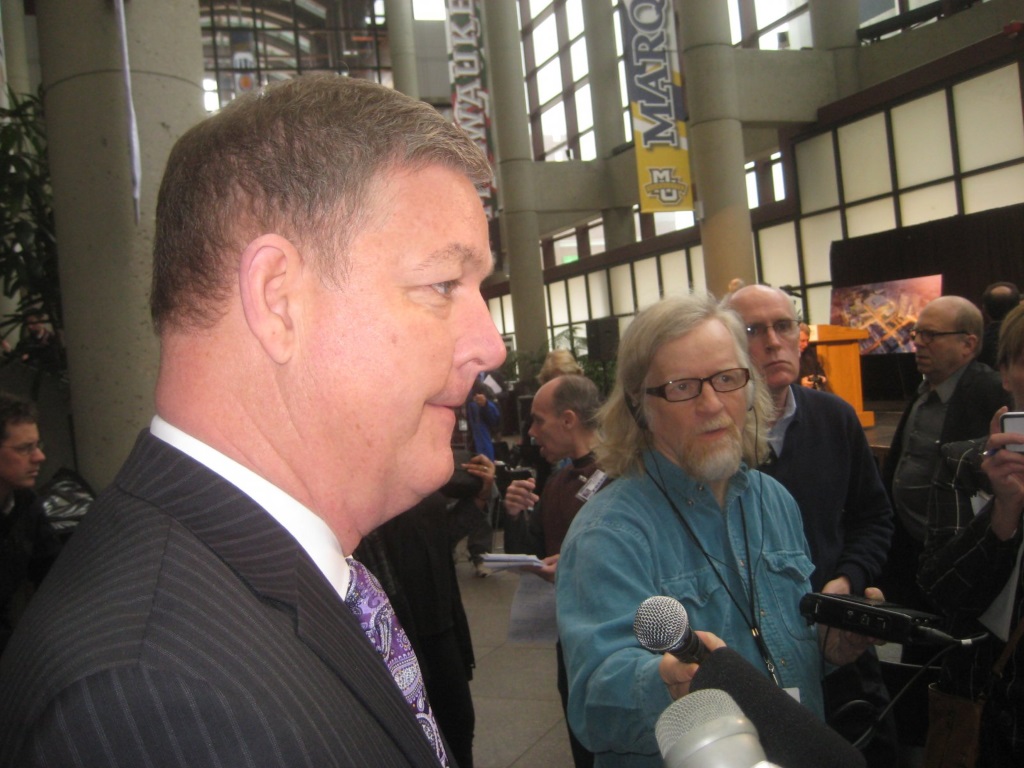Where Are Top CEOs on City’s Unrest?
The silence is deafening. But Mayor Barrett says they want to help.
Metropolitan Milwaukee Association of Commerce President Tim Sheehy doesn’t run a travel agency but he’s been getting “nasty emails,” he says, from people around the country telling him they will never come to Milwaukee given the violence that erupted this past weekend. Media across the nation have done countless stories portraying Milwaukee as a city beset by segregation, social problems and ugly divisions. It’s not travel brochure material.
The arson and violence that occurred in Milwaukee’s central city, whatever the spark that started it, was an obvious cry for help from a impoverished community that badly needs more jobs, more investment, more hope. It’s the kind of situation that might have once prompted public statements of concern by the town’s top business leaders.
But today’s big corporations are global companies. “Rockwell does 40 percent of its business outside the country. For Manpower it’s probably 80 percent,” Sheehy estimates. Customers in the state are a tiny portion of their business, much less customers in the metro area, so how much can these business leaders concern themselves with local problems?
“I have found they will take the time on issues like this,” Sheehy says. But quietly. “Today’s CEOs tend to speak in a different way than they did years ago,” he adds.
“I have had an outpouring of responses from members saying ‘how can I help,” Sheehy says. He notes that one of the top CEOs in town said he would call officials with British Petroleum to make sure a gas station that was torched over the weekend gets reopened.
“If the mayor asked for a meeting on a topic like this I think all the top CEOs would be at the table,” Sheehy says.
Mayor Tom Barrett says he’s already asked for a meeting with MMAC leaders. He notes that the CEOs of Northwestern Mutual and Johnson Controls have reached out to him. “A lot of civic pride has been expressed,” Barrett says, by leaders in the community he’s heard from.
“I’ve talked about what I saw when I was in Israel,” Barrett says. “Their attitude after a bombing was we’re going to be rebuilding right away. That’s what I want to see in this area.”
While emphasizing that the weekend of violence was much smaller than the 1967 riot in Milwaukee, Barrett says its critical to avoid what happened in the aftermath of the riot, when many businesses left the area. “I’m determined to not let that happen.”
The first goal, he says, is to make sure all the businesses that were burned or damaged reopen, and he’s reaching out to all those companies with that in mind. He’s also talking to state legislators about the Wisconsin Economic Development Corporation (WEDC), about getting grants from that agency to help rebuild and even expand businesses in the central city.
Sheehy has created a list of long-term goals that could improve life for residents in majority-black North Side neighborhoods, including:
-increase funding for daycare centers so they can improve the quality of their offerings, and if they don’t, reduce their funding or eliminate it (cost still to be determined);
-Fully fund K4 education for low income students in Milwaukee over the next two state budgets (cost $25 million);
-Increase special education funding by 10 percent over the next two state budgets (cost $104 million);
-Close the per pupil gap in funding for Charter and Choice schools compared to public schools ($50 million).
“If those choice and charter schools didn’t exist and those students went back to MPS, that would cost the state another $230 million,” Sheehy notes, arguing for more money to be funneled to the city.
With the exception of day care, which involves federal funding, all of Sheehy’s other goals involve state funding, and the state hasn’t been very friendly to Milwaukee under Gov. Scott Walker and Republican legislative control.
Sheehy, however, says Walker has indicated that K-12 education is more of a priority. “I think there’s an appetite for some of this,” he says.
But will the business community lean on the legislature to provide more funding to Milwaukee? Will business leaders see the city as an important priority?
Sheey says “we clearly have a lot of work to do as a metro community to understand we have a metro economy.” In short, if Milwaukee falls, the whole metro area will decline.
“The majority of residents in Waukesha, Washington and Ozaukee County don’t earn their money in their own county. There’s $11 billion a year in personal income and wages earned in Milwaukee County by residents of these other counties,” Sheehy notes.
“You can’t look at the challenges and assets of the metro area on a county by county basis,” Sheehy adds. “You’ve got to look at Milwaukee as a whole.”
Barrett points to the huge 30th Street Corridor project has something that could lead to jobs for north side residents. “The city has invested millions and it’s ready to go. We need private sector investment from businesses.”
While the long-term goals Sheehy is pushing for could be very helpful, it’s critical that residents in the area that exploded see something happen — some signs of hope — on a short-term basis, whether it’s new businesses, job training or WEDC-funded projects of some kind.
Barrett’s chief of staff Pat Curley calls the situation “an opportunity,” a galvanizing event that might bring everyone together. “It’s a challenge to all of us, to the mayor, the Common Council, the business community and to Governor Walker and the legislature. As the mayor has said, we are all in this together.”
Except that we haven’t been in the past. History will be watching to see how our leaders — how all of us — respond to this crisis.
Political Contributions Tracker
Displaying political contributions between people mentioned in this story. Learn more.
- February 3, 2016 - Tom Barrett received $400 from Tim Sheehy
Murphy's Law
-
Climate Has Changed for Sewerage District
 Apr 10th, 2024 by Bruce Murphy
Apr 10th, 2024 by Bruce Murphy
-
Is Legislature Biased Against Working Class?
 Apr 4th, 2024 by Bruce Murphy
Apr 4th, 2024 by Bruce Murphy
-
Associated Press Will Decline in Wisconsin
 Mar 27th, 2024 by Bruce Murphy
Mar 27th, 2024 by Bruce Murphy


















Joseph Rodriguez, a UWM professor of history and urban studies, wrote a book called “Bootstrap New Urbanism: Design, Race & Redevelopment in Milwaukee.”
From a review, here’s a summary of his take on the city’s ability to “solve” long-time problems through “bootstrapping.”
“Rodriguez, a UWM associate professor of history and urban studies, also focuses on ways redevelopment efforts have fallen short. Milwaukee, like other cities, has declined over decades, the result of powerful economic forces (including globalization), tremendous flight to the suburbs, and the loss of good jobs in the city. These left a legacy of persistent poverty, racial and ethnic segregation, and troubled schools and neighborhoods, all of which, he asserts, cannot be overcome simply by people pulling themselves up by their bootstraps.
Rodriquez does not pull punches about practices and attitudes that reinforced racial segregation and inequality. He lays bare the impact of the abdication by suburbanites in addressing city problems caused or aggravated by suburbanization.”
https://bayviewcompass.com/book-review-bootstrap-new-urbanism-design-race-and-redevelopment-in-milwaukee/
As Sheehy points out, many suburbanites depend on Milwaukee (city & county) for their livelihoods ($11 billion) but are not engaged with issues facing the city. Sheey says “we clearly have a lot of work to do as a metro community to understand we have a metro economy.”
Maybe it is time for Milwaukee to prioritize: Arenas or Trolleys vs kids reading , jobs, roads, crime, more cops??
Let us not forget one of the main driving forces of white flight to the suburbs was Milwaukee Public schools dictating to Milwaukeans that they can no longer go to their neighborhood public schools in the 1970’s. For the next forty years MPS spent tens of millions of tax payer dollars sending students on long rides through the city of MIlwaukee.
“Barrett points to the huge 30th Street Corridor project has something that could lead to jobs for north side residents. “The city has invested millions and it’s ready to go. We need private sector investment from businesses.””
Barrett talked to me about the 30th Street Corridor, more or less the same way, when he took office in 2004. That was 12 years ago.
@Tom Well since then the city has actually spent millions (pretty sure they hadn’t spent any in 2004). Acquired properties, cleaned up brownfields, a developer has built a new industrial building, Talgo happened (though this building is now being used as part of the NM project). Like the Valley was/is, it’s a long-term effort.
Also didn’t Tower Automotive close in 2006?
In 1974 I put together a plan to bust up MPS so the neighborhoods cauldron the schools. not the dictatorship gang on Vliet St.
When you presented the plan did you call everyone else in the room a white liberal racist like you do here?
Vince, In the end you have probably won. The Reagan 3 prong coalition is done. There are less religious people now. Women control most house holds and are more concerned about abortion then the defense budget. Thirty year old men sit in mommies basement and buffet on pornography and the Xbox. A tax cut given to a family of fours bottom line is now considered a white privilege. Your side has won. You own Sherman Park as you have the last century by Democratic power and with Hillary’s win you can scale back gun rights, and own immigration, medicare and SSI. Don’t forget to save the earth from its own destruction as Obama did with race relations.
So you’re a misogynist too Jason? How shocking that “your side” is losing when in 2016 it’s primarily made up of xenophobic misogynist white males. Maybe you should join the 21st century. That post is pathetic. The ranting of a white male terrified of a world that isn’t as white as it was when he was a kid. A world where GASP women work. You are a sad, sad man.
Many of the top CEOs are making a difference. They contribute their time and money to Milwaukee area endeavors.
It it may be seen as self serving for an ndividuals to list all of the ways that they do contribute. Some notable charities are quite active in the area affected by the violence. Many executives give money and time to those fine organizations.
The business community may be considered as not doing enough. We should be aware of how much they have done.
The city burns and were concered about where the job makers are? Are they socialogist now? We do know one thing don’t bother Barack as democratic strong holds burn and Louisiana is underwater..Barry’s playing golf.
Better Barry cannot do anything anyway, Trump can probably fix things, he know how to do that.
Trump can fix things. Right. He’s in debt at least $650 million but he can fix things. Filed bankruptcy repeatedly but he can fix things. Amazing that he’s gotten people to believe that.
The real reason Jason and WCD support Trump. It sure ain’t economics. https://www.washingtonpost.com/politics/racial-realists-are-cheered-by-trumps-latest-strategy/2016/08/20/cd71e858-6636-11e6-96c0-37533479f3f5_story.html?hpid=hp_hp-top-table-main_altright745pm%3Ahomepage%2Fstory
For the past two/three years I, on behalf of the Schrager family, have been trying to turn the former Schrager Auction Galleries, an iconic landmark located on the NW corner of Sherman & Locust, into a Community Center which would focus on the needs of the residents of the Sherman Park area. So far, our Mayor, along with Aldermen and other elected officials, have shown little if any interest in this project. This building, which has 40,000 Square feet of space including a magnificent 1,400 seat auditorium with a stained glass dome ceiling, can be purchased for less money than it takes to incarcerate 15 people for a year – 40% of whom are imprisoned not for breaking a law, but for breaking a parole violation. Wouldn’t it make more sense to put the money into projects like a Schrager Community Center, which would offer young people guidance, direction, education, arts, entertainment etc. and engage them in positive activities which may not be an option for them now. If 9interested in participating in this project, please contact me, Wolfgang, at wrosenau@att.net. Thank you.
Wolfgan- im the sole breadwimner for a typical family of 4 and we live very very tightly . Is there something we could do to support this that isn’t financial?
Re: Comment 15: It’s telling–and more than sad–that City of Milwaukee officials have resisted efforts to create a community/cultural center in Sherman Park.
We can only hope some city officials will begin to invest in this historic & diverse neighborhood. Residents, private & philanthropists and community groups cannot do it alone. Good luck Wolfgang Rosenau, Schrager Family, Reggie Baylor and other visionaries.